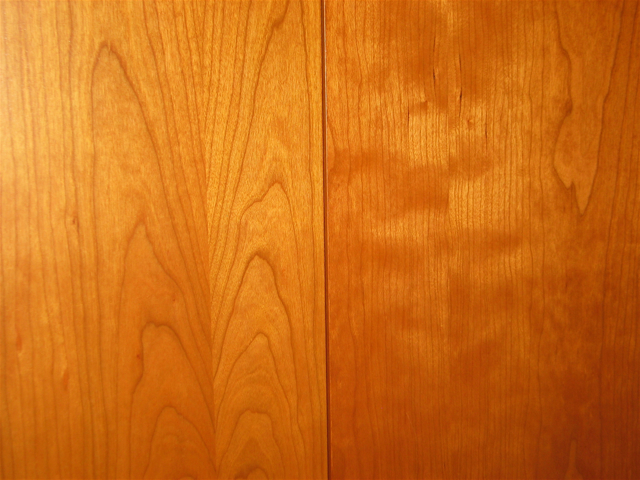We may receive a commission when you use our affiliate links. However, this does not impact our recommendations.

The degree cherry blotches depends on the wood or veneer, not on how a stain or finish is applied. The veneered cabinet door on the left didn’t blotch while the door on the right did, both with no stain applied.
Cherry is a beautiful and easy-to-work wood. But it is a problematic wood to finish because it has a tendency to blotch, even with just a finish applied – no stain.
Everyone working with cherry wants to know the “secret” for avoiding blotching in cherry, as if there is one that they just don’t know. The real secret about cherry blotching seems to be that there isn’t any way to avoid the blotching. If the cherry boards or veneer you are using include blotchy areas, you are going to get blotching.
The only way to avoid blotching is to use boards or veneer that don’t blotch, or cut out the blotchy areas from boards or veneer that do blotch.
You can test if the wood is going to blotch by wetting it. Be aware that using water will raise the grain, and using mineral spirits could cause leveling problems if you intend to use a water-based finish. Denatured alcohol won’t cause any problems and is fairly safe to work with, but it evaporates rapidly, so you need to be quick.
Blotching is not necessarily bad. It can be very beautiful. The curls in curly maple, for example, are blotching.
Here are some supplies and tools we find essential in our everyday work around the shop. We may receive a commission from sales referred by our links; however, we have carefully selected these products for their usefulness and quality.









I have had good results reducing (not eliminating) blotch by sanding to high grit before finishing. Christian Becksvoort writes about this in “Shaker Inspiration.” I sand cherry to 600 grit but supposedly it gets better if you go higher.
Well, a wash coat (or two) with a thinned (1 lb) bleached shellac works perfectly with any blotch inclined wood even pine.
I agree with Bob that care needs to be taken in the wood selection but take issue with the use of the word “blotching” when stain is not involved. The difference between the two panels is the result of varying reflectivity of the wavy grain in the right panel. What looks dark from one angle will look light from another and vice-versa.
I think “blotching” should be reserved for describing the way the right panel would absorb stain differently depending on where the wavy grain breaks the surface plane.
Where end grain breaks the surface (the wave is sheared by the plane) that grain will need to be filled with something to limit it’s ability to absorb stain. Otherwise the end grain area would always be darker than it’s surrounding and would look “blotchy”.
Filling the end grain with a stain resist would not prevent the variation in reflection but I wouldn’t call that “blotchy”.
I would like to know if Bob Flexner has ever tried Charles Neil’s Blotch Control? Two coats of this product applied with ample drying time and a top coat of your choice will produce a blotch free finish on cherry. I have produced several cherry pieces of furniture that are all blotch free because they first received two coats of Charles’ Blotch Control before I applied dye and an oil finish. When people see my cherry pieces, they often ask, “Where are the blotches? Why didn’t your cherry blotch?” I then always tell them about Charles Neil’s Blotch Control…